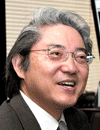08:00 | Conference Registration, Materials Pick-Up, Coffee and Tea in the Exhibit Hall |
|
Session Title: Conference Opening Session |
| |
|
Session Chairperson: Dr. Claudia Gärtner, CEO microfluidic ChipShop GmbH Germany |
| |
09:00 |  | Conference Chair Welcome and Introduction by Conference Chairperson: Emerging Themes in Microfluidics 2023
Claudia Gärtner, CEO, microfluidic ChipShop GmbH, Germany
|
|
09:30 |  | Keynote Presentation Nanobiodevices, Quantum Life Science, and AI for Future Healthcare
Yoshinobu Baba, Professor, Nagoya University, Japan
We have investigated nanobiodevices, quantum life science, and AI for biomedical applications and healthcare. Nanowire devices are extremely useful to isolate extracellular vesicles from body fluids and vesicle-encapsulated microRNA analysis. The device composed of a microfluidic substrate with anchored nanowires gives us highly efficient collections of extracellular vesicles in body fluids and in situ extraction for huge numbers of miRNAs (2,500 types) more than the conventional ultracentrifugation method. Nanowire devices gave us the miRNA date for several hundred patients and machine learning system based on these miRNA data enabled us to develop the early-stage diagnosis for lung cancer, brain tumor, pancreas cancer, liver cancer, bladder cancer, prostate cancer, diabetes, heart diseases, and Parkinson disease. Nanowire-nanopore devices combined with AI (machine learning technique) enable us to develop mobile sensors for SARS-CoV-2, PM2.5, bacteria, and virus in the environment. MEXT Quantum Leap Flagship Program (Q-LEAP), which I lead, has been developing biological nano quantum sensors, quantum technology-based MRI/NMR, and quantum biology and biotechnology. Nanodiamonds, with nitrogen-vacancy centers, and quantum dots are applied to develop quantum sensors for quantum switching intra vital imaging for iPS cell (induced pluripotent stem cells) based regenerative medicine, and quantum photo immuno-therapeutic devices for cancer. Multifunctional quantum nanoparticles were developed for fluorescence/MR bimodal in vivo imaging-guided potothermal-intensified chemodynamic synergetic therapy of targeted tumors. |
|
10:15 |  | Keynote Presentation Microfluidic Approaches to Isolating Micro- and Nanoscale Circulating Biomarkers for Cancer Diagnosis and Monitoring
Chwee Teck Lim, NUS Society Chair Professor, Department of Biomedical Engineering, Institute for Health Innovation & Technology (iHealthtech), Mechanobiology Institute, National University of Singapore, Singapore
Microfluidics has emerged as a powerful technology not only for biological but also clinical research and applications. For example, the ability to manipulate and analyse minute volume of fluids and samples has led to a wealth of new biological assays which can provide unique approaches for better manipulation and capture of micro- and even nanoscale circulating biomarkers such as cells, extracellular vesicles and exosomes. With these new tools, researchers are not only being led to new questions and discoveries, but also applications in disease diagnosis, monitoring and even therapy. Here, I will present several microfluidic technologies that we have developed for both biological and clinical applications relating to diseases such as cancer. These includes microfluidic chips for rare diseased cell separation and culture as well as capture of extracellular vesicles and exosomes.
|
|
10:45 | Mid-Morning Coffee and Tea Break and Networking in the Exhibit Hall |
11:15 |  | Keynote Presentation Chemically Programmable Isothermal PCR Enables Rapid Nucleic Acid-based Bioanalysis at the Point of Need
Victor Ugaz, Professor & Interim Department Head, Texas A&M University, United States of America
The polymerase chain reaction (PCR) and its variants are analytical gold standards for nucleic acid-based testing that play a critical role in diagnosing and monitoring infectious diseases. But robust portable PCR-based testing at the point of need (PON) remains elusive, especially in resource-limited settings, because the required thermocycling instrumentation is neither amenable to nor validated for operation in a portable format. This presentation describes a microfluidic platform that overcomes these barriers by exploiting the ability to perform isothermal PCR via natural convection. We apply “chemical programming” to manipulate the interplay between the PCR biochemistry and the microscale convective flow field, enabling 100% repeatability to be achieved in a format that can be easily and cost-effectively manufactured, dramatically increasing simplicity, portability, and affordability. We demonstrate rapid replication of targets associated with multiple pathogens, including SARS-CoV-2, attaining performance rivaling ultra-fast PCR instruments while using lower reagent concentrations than conventional protocols. This discovery paves the way for widespread adoption of PCR-based analysis at the PON, making it possible to bring lab-quality diagnostics to decentralized settings. |
|
11:45 |  | Keynote Presentation Emerging Trends in Microfluidics Inspired by Nature
Anderson Shum, Professor, Department of Mechanical Engineering; Director, Advanced Biomedical Instrumentation Centre, University of Hong Kong, Hong Kong
The field of microfluidics has led to a wide variety of advances in bioanalyses, fluid characterization, materials design and many other applications. Microfluidics is now commonly used as a tool well integrated into the final application. Further development of the field of microfluidics requires new ideas in the design of the microfluidic devices and strategies in general. In this talk, I will discuss a few potential trends in the devices, for instance, by making the devices more responsive to the environment, enhancing the exchange of materials with the micro-environment and extending to a wider range of fluids. The resultant devices enable microfluidics to capture advantages and features that are often observed in Nature, such as in plants, vasculature, and cellular environment. |
|
12:15 | 3D Printed Microfluidic Gadget for Biomedical Daily Grind: From Culturing Tumor Spheroids to Niche Recapitulation
Liang Zhao, Associate Professor, Beijing University of Technology, China
Looking back the history of the microfluidics’ development, all the key surging points was initiated from the application of new fabrication modality, such as soft-lithography-based prototyping, which revolutionized this field by greatly lowering the accessibility of microfabrication. We believe the trend for lowering and democratizing the fabrication process should keep going on because biologists begin to harness the microengineering technologies to address the problems during biological experiments such as building and recapitulating organ-like functions on a transparent circuit with highly temporal-spatial controllable way. Herein we present an easy operating microfluidic physiological system that enables liver-tumor spheroids interactions within a 3D printing-cast-based microfluidic chip, recapitulating the liver-tumor microenvironment with an integrative format.
|
12:45 | Networking Luncheon in the Exhibit Hall -- Network with Exhibitors, View Posters and Engage with Colleagues. **Lunch is Japanese Bento** |
|
Session Title: Lab-on-a-Chip and Microfluidics -- Current Landscape and Applications Segments |
| |
14:00 |  | Keynote Presentation RNA Sequencing using a Nanofluidic Device with Dual In-Plane Nanopore Sensors
Steve Soper, Foundation Distinguished Professor, Director, Center of BioModular Multi-Scale System for Precision Medicine, The University of Kansas, United States of America
With the development of next generation sequencing (NGS), the field of transcriptomics has seen tremendous advancements opening up opportunities for improved diagnostics of diseases such as cancers and infectious diseases. RNA sequencing enables measurement of single nucleotide variants (SNVs), insertions and deletions, detection of different transcript isoforms, splice variants, and chimeric gene fusions. Although NGS has been useful for unraveling RNA structure and function, several technical difficulties remain including the need for reverse transcription and PCR amplification, which can mask epitranscriptomic modifications. To address NGS issues, we are developing an exciting new sequencing technology called Exonuclease Time-of-Flight (X-ToF) for the label-free detection and identification of single molecules. The hypothesis behind X-ToF is, “individual molecules moving electrokinetically through a 2D nanotube will experience a time-of-flight (ToF) that is dependent upon its molecular identity.” X-ToF is a nanofluidic device comprised of input/output channels, a nano-scale enzymatic bioreactor, and a flight tube equipped with a pair of in-plane nanopores to measure the ToF of a single ribonucleotide monophosphate (rNMP). Each rNMP is produced from an unamplified RNA molecule using a processive exoribonuclease, XRN1. In this presentation we will discuss the high rate manufacturing of the X-ToF chip with sub-5 nm in-plane nanopores using nano-injection molding from a cyclic olefin polymer (COP) plastic. The in-plane pores are situated at either end of a nanochannel (50 x 50 nm; 5 µm long) that generate current transient signals to detect and deduce the identity of rNMPs. The ToF is dependent on the apparent electrophoretic mobility of the molecule. The identity is determined from the ToF, the current transient amplitudes, and dwell times using multi-parameter Principle Component Analysis (PCA). We will show the ability to detect (detection efficiency ~100%) single rNMPs with identification accuracies >98%. Finally, we will discuss the generation of solid-phase nano-bioreactors using XRN1, which can cleave ssRNA in the 5’ to 3’direction releasing rNMPs. Unique properties of the immobilized enzyme will be presented in terms of its processivity and kinetic rate of cleaving single RNA molecules. |
|
14:30 |  | Keynote Presentation Droplet-Based Microfluidics to Detect Cancer Circulating Biomarkers: From Technology Development to Clinical Validation
Valérie Taly, CNRS Research Director, Professor and Group leader Translational Research and Microfluidics, Université Paris Cité, France
Droplet-based microfluidics has led to the development of highly powerful tools with great potential in High-Throughput Screening where individual assays are compartmentalized within aqueous droplets acting as independent microreactors. Thanks to the combination of a decrease of assay volume and an increase of throughput, this technology goes beyond the capacities of conventional screening systems. Added to the flexibility and versatility of platform designs, such progresses in the manipulation of sub-nanoliter droplets has allowed to dramatically increase experimental level of control and precision. The presentation will aim at demonstrating through selected example, the great potential of this technology for biotechnology and cancer research. First, we will show how by combining microfluidic systems and clinical advances in molecular diagnostic we have developed an original method to perform millions of single molecule PCR in parallel to detect and quantify a minority of target sequences in complex mixture of DNA with a sensitivity unreachable by conventional procedures. Technological development allowing for the multiplex detection of cancer biomarkers will be presented. The presentation will also illustrate the pertinence of the developed procedures to overcome clinical oncology challenges, the results of several clinical studies will be presented. In particular, applications of droplet-based digital PCR to the follow-up of both advanced and localized cancers will be presented. |
|
15:00 |  | Keynote Presentation New Opportunities to Detect Disease and Probe Microbials Using Lab-on-a-Chip Devices
Amy Shen, Professor and Provost, Okinawa Institute of Science and Technology Graduate University, Japan
Microfluidics and lab-on-a-chip devices have emerged as powerful platforms to manipulate fluids at small length-scales and open up new possibilities in biophysics and biotechnology research. In this talk, I will showcase two examples of using microfluidics for microbial population research and disease diagnosis.
- A microfluidic device with controlled microenvironment is developed to study population genetics: many microbial populations proliferate in small channels. In such environments, reproducing cells organize in parallel lanes. Reproducing cells shift these lanes, potentially expelling other cells from the channel. We combine theory and experiments to understand how these dynamics affects the diversity of a microbial population.
- The rapid transmission and resilience of COVID-19 have led to urgent demands in monitoring humoral response for effective vaccine development, thus a multiplex co-detection platform to discriminate infection-induced from vaccine-induced antibodies is needed. A duplex electrochemical immunosensor for co-detection of anti-nucleocapsid IgG (N-IgG) and anti-spike IgG (S-IgG) is developed by using a two-working electrode system, via an indirect immunoassay, with antibody quantification obtained by differential pulse voltammetry. This duplex immunosensor is then integrated in a microfluidic device to obtain significantly reduced detection time < 7 min) while maintaining its analytical performance. Our duplex microfluidic immunosensor can be easily expanded into multiplex format to achieve high throughput screening for the sero-surveillance of SARS-CoV-2 and other infectious diseases.
|
|
15:30 | Mid-Afternoon Coffee and Tea Break and Networking in the Exhibit Hall |
16:00 |  | Keynote Presentation Node-Pore Sensing: A Versatile Method to Phenotype Single Cells
Lydia Sohn, Almy C. Maynard and Agnes Offield Maynard Chair in Mechanical Engineering, University of California-Berkeley, United States of America
We have developed an electronic method to screen cells for their phenotypic profile, which we call Node-Pore Sensing (NPS). NPS involves using a four-terminal measurement to measure the modulated current pulse caused by a cell transiting a microfluidic channel that has been segmented by a series of inserted nodes. Previously, we showed that when segments between the nodes are functionalized with different antibodies corresponding to distinct cell-surface antigens, immunophenotyping can be achieved. By simply inserting between two nodes a straight “contraction” channel through which cells can squeeze, we can mechanophenotype single cells, simultaneously measuring their size, resistance to deformation, transverse deformation, and ability to recover from deformation. When the contraction channel is sinusoidal in shape, resulting in cells being periodically squeezed, mechano-NPS can also measure the viscoelastic properties of single cells. I will describe how we have used NPS to distinguish chronological age groups and assess breast cancer susceptibility in women.
|
|
16:30 |  | Keynote Presentation Modular Design of 3D Printed Microfluidics for Bioprocess Applications
Noah Malmstadt, Professor, Mork Family Dept. of Chemical Engineering & Materials Science, University of Southern California, United States of America
As 3D printing replaces traditional clean room manufacturing for microfluidic engineering applications, it’s becoming clear that this transition offers not only lower cost and faster design iterations, but also new opportunities for fluidic routing and control that are only possible due to the inherent three-dimensional nature of these systems. Over the past several years, we have developed design principles that take advantage of this three-dimensionality, as well as demonstrating several applications that benefit from this approach. At the core of these design principles is the modularity of microfluidic unit operations. In addition to designing prototypical unit operations such as mixers, splitters, flow focusers, droplet generators, thermal and optical sensors, and world-to-chip interfaces, we have developed systematic approaches to combining these modules into microfluidic circuits with predictable behaviors. This approach can be used to rapidly prototype complex microfluidic operations by assembling physically distinct modules as well as to design monolithic microfluidic devices which can be printed in a single run. We have demonstrated the power of this approach by building several micro- and milifluidic systems for bio-analysis and bioprocess applications. These include systems for biomarker diagnostics, automated high-throughput affinity screening, and rapid manufacturing of vaccine lipid nanoparticles. We have also demonstrated how entire systems can be treated as modules, allowing for scaling of bioprocess production lines by massive parallelization. |
|
17:00 |  | Keynote Presentation Lab on a Particle Technology for Functional Discovery of Rare and Unconventional T-Cell Receptors
Dino Di Carlo, Armond and Elena Hairapetian Chair in Engineering and Medicine, Professor and Vice Chair of Bioengineering, University of California-Los Angeles, United States of America
Lab on a particle technologies are emerging as a rapidly adopted platform for performing single-cell functional screening leveraging standard instrumentation, such as flow cytometers and microfluidic single-cell sequencing platforms. Each cell and its secreted products can be analyzed and sorted using widely available fluorescence activating cell sorters operating at up to a 1000 cells per second, promising to democratize single-cell technologies. The platform enables sorting cells based on secreted products for the discovery of antibodies, the development of cell lines producing recombinant products, and the selection of functional cells for cell therapies. Here, I will describe our progress in using nanovial particles for the characterization and discovery of antigen-specific and metabolite-specific T cells. Nanovials enable selective binding, functional characterization of secretion of cytokines and other effector molecules, and sorting of T cells for downstream T-cell receptor sequencing and functional annotation. We apply oligo barcoding technology to both multiplex target antigens and functional performance and link this to the TCR sequence information. Nanovials can enable more rapid discovery of cancer-specific TCRs and TCRs against metabolites presented by unconventional MHC-like molecules, with high accuracy, promising to transform the discovery of critical recognition elements for improved T cell therapies. |
|
17:30 | Networking Reception in the Exhibit Hall with Japanese Beer and Sake |
18:30 | Close of Day 1 Conference Programming |















